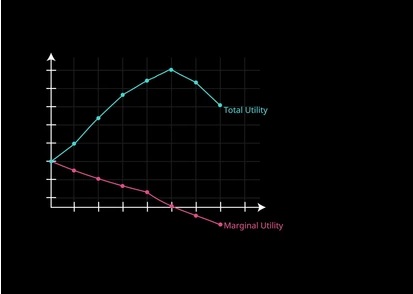📊 Understanding the Law of Marginal Utility: The Core of Consumer Behavior in Economics
In the world of economics, where choices and preferences shape market dynamics, one concept stands out in explaining how consumers make decisions — the Law of Marginal Utility. Whether it’s your craving for another slice of pizza or the decision to buy yet another gadget, this fundamental law plays a crucial role in shaping what and how much you consume.
🔍 What is Utility?
Utility refers to the satisfaction or benefit derived from consuming a product or service. It is a subjective measure that varies from person to person based on preferences and needs.
-
Total Utility: The overall satisfaction received from consuming a certain quantity of goods.
-
Marginal Utility: The additional satisfaction gained from consuming one more unit of a good or service.
📘 Definition of the Law of Marginal Utility
Definition:
The Law of Marginal Utility states that as the quantity of a good consumed increases, the marginal utility derived from each additional unit tends to decrease, assuming all other factors remain constant.
This concept is also known as the Law of Diminishing Marginal Utility.
🍕 A Real-Life Example
Imagine you’re eating slices of pizza:
-
The 1st slice brings immense joy — you’re hungry!
-
The 2nd slice still tastes great but not as amazing.
-
By the 4th or 5th slice, you’re full — each additional slice offers less satisfaction.
-
Eventually, eating another slice might even make you uncomfortable — utility becomes zero or negative.
This diminishing level of satisfaction per additional unit is diminishing marginal utility.
🧠 Key Assumptions of the Law
For the law to apply effectively, certain assumptions must hold true:
-
Rational Consumer: The consumer aims to maximize satisfaction.
-
Homogeneous Units: Each unit of the good is identical in quality and size.
-
Continuous Consumption: Consumption happens in a continuous manner without large time gaps.
-
No Change in Taste or Income: The consumer’s preferences, income, and the price of goods remain constant.
🧾 Importance in Economics
The Law of Marginal Utility is foundational in:
1. Consumer Demand
It helps explain why demand curves slope downward. As utility diminishes, consumers are willing to pay less for each additional unit.
2. Price Determination
In pricing strategy, firms understand that the value a customer places on a product declines with quantity.
3. Resource Allocation
It guides how limited resources should be allocated to maximize overall satisfaction.
4. Taxation Policies
Governments use this principle to justify progressive taxation — as income increases, the marginal utility of money decreases, so higher incomes are taxed more.
📉 Marginal Utility and Law of Equi-Marginal Utility
A related concept is the Law of Equi-Marginal Utility, which states:
Consumers allocate their income across goods in such a way that the utility per rupee spent is equalized across all goods.
Mathematically:
MUx/Px = MUy/Py = MUz/Pz = … = MUn/Pn
Where MU = Marginal Utility, P = Price of the good
This helps consumers optimize their limited income to get maximum satisfaction.
💬 Criticism of the Law
While widely accepted, the law has its limitations:
-
Not always measurable: Utility is subjective and difficult to quantify.
-
Assumes rationality: Real-world decisions are often emotional or impulsive.
-
Not applicable to all goods: Certain experiences (like collecting art or social media likes) may not follow diminishing utility patterns.
✅ Conclusion
The Law of Marginal Utility is more than just an economic principle — it’s a lens through which we can understand human behavior. From marketing strategies to government policies, its influence is vast and deep-rooted. By recognizing how satisfaction changes with consumption, individuals and organizations can make smarter, more efficient choices in an ever-demanding world.

